|
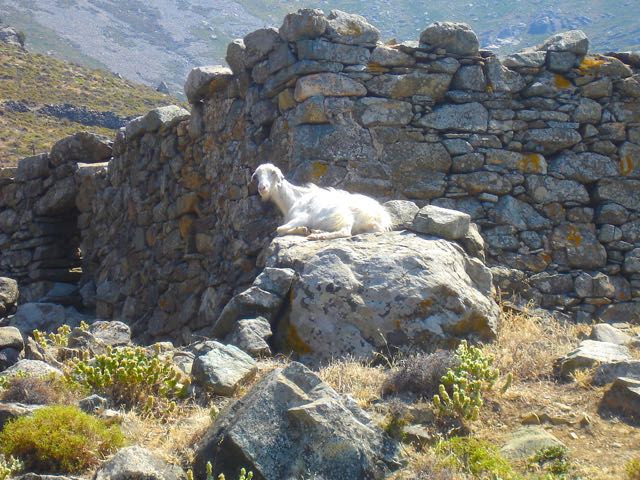 If you are not the type who really likes hanging out all day on the beach what is there to do in Tinos? Get in your car or hit the walking trails and explore. What really makes Tinos special are the many villages scattered around the island, each one different and all of them connected by excellent roads and a system
of walking paths which follow the kalderinia, the stone roads that the islanders have been using for centuries. These villages are considered to be the
model of the Cycladic architecture and contain picturesque arches, streets paved with flagstones and yards full of blooming flowers, churches both small and large, and fountains of clear running water from underground springs. Most of these villages have been declared traditional and are protected by the Greek Ministry of Culture. If you are not the type who really likes hanging out all day on the beach what is there to do in Tinos? Get in your car or hit the walking trails and explore. What really makes Tinos special are the many villages scattered around the island, each one different and all of them connected by excellent roads and a system
of walking paths which follow the kalderinia, the stone roads that the islanders have been using for centuries. These villages are considered to be the
model of the Cycladic architecture and contain picturesque arches, streets paved with flagstones and yards full of blooming flowers, churches both small and large, and fountains of clear running water from underground springs. Most of these villages have been declared traditional and are protected by the Greek Ministry of Culture.
|
|
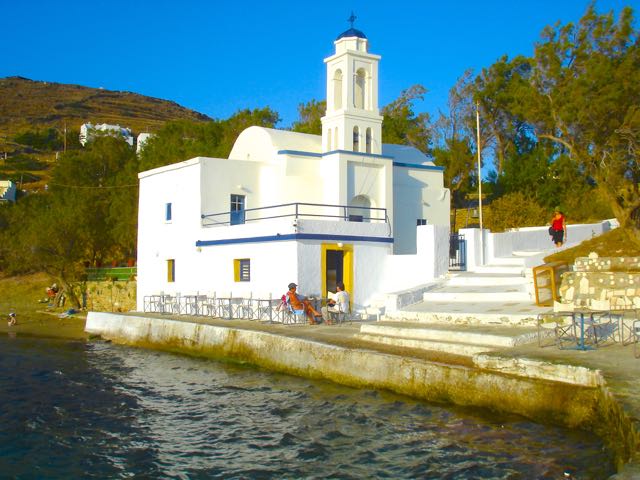 The majority of the villages are located in the southeast quadrant of Tinos and you can find a good reason to visit any of them. Some villages are Catholic and some Greek Orthodox and all have churches of their particular faith, many of them quite beautiful. In fact Tinos has over one thousand Churches, compared to decadent
islands like Mykonos which only has something like 365. It is said that the ecclesiastical architecture
of Tinos with its simple beauty and religious faith is the perfect physical manifestation of spirit. While giant Churches like those in Western Europe or Agia Sophia in Constantinople seem to almost challenge God, the small country churches of Tinos, solitary and white have a beauty and humility that induces a meditative state rather than a sense of awe. The majority of the villages are located in the southeast quadrant of Tinos and you can find a good reason to visit any of them. Some villages are Catholic and some Greek Orthodox and all have churches of their particular faith, many of them quite beautiful. In fact Tinos has over one thousand Churches, compared to decadent
islands like Mykonos which only has something like 365. It is said that the ecclesiastical architecture
of Tinos with its simple beauty and religious faith is the perfect physical manifestation of spirit. While giant Churches like those in Western Europe or Agia Sophia in Constantinople seem to almost challenge God, the small country churches of Tinos, solitary and white have a beauty and humility that induces a meditative state rather than a sense of awe.
|
|
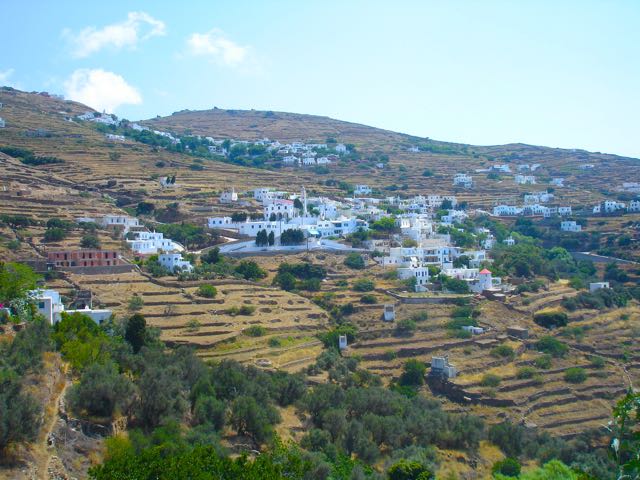 As in other Cyclades islands you will notice the stone terracing which is pretty much everywhere keeping the topsoil in place and turning steep hillsides that might otherwise be barren into farms and orchards that can last a thousand years. As far as vegetation goes Tinos is one of the more green islands with fertile valleys
with
ample water able to sustain the whole island were it necessary. But more than anything Tinos has stone: marble, granite and slate, and just about everything is built out of these rocks, from walls to streets to monuments and art. No wonder Tinos is known for its sculpture artists, and the father of Phideas, acknowledged as the greatest sculptor of all time whose most well known work was the Parthenon, came from Tinos. As in other Cyclades islands you will notice the stone terracing which is pretty much everywhere keeping the topsoil in place and turning steep hillsides that might otherwise be barren into farms and orchards that can last a thousand years. As far as vegetation goes Tinos is one of the more green islands with fertile valleys
with
ample water able to sustain the whole island were it necessary. But more than anything Tinos has stone: marble, granite and slate, and just about everything is built out of these rocks, from walls to streets to monuments and art. No wonder Tinos is known for its sculpture artists, and the father of Phideas, acknowledged as the greatest sculptor of all time whose most well known work was the Parthenon, came from Tinos.
|
|
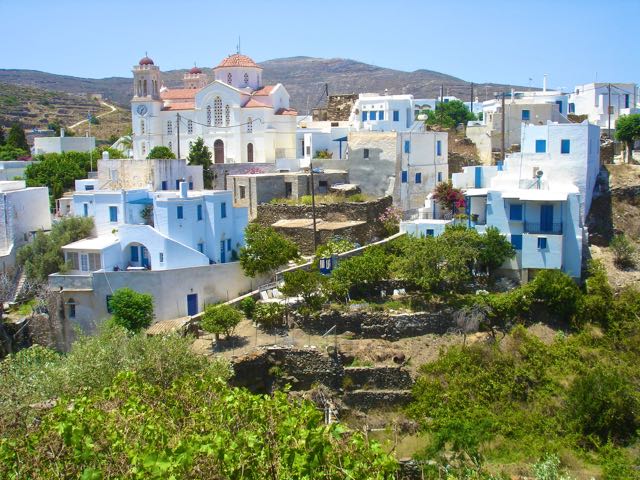 The three villages of Dio Horia, Triandaros and Berdemiaros are known as the 'balconies of Tinos' because of their spectacular view of the sea. Dio Horia is build ampitheatrically (I don't know if this is a real word but it works even if my spell-check does not like it) on the side of a mountain
and has a fountain enclosed in marble with a painting of the Panagia with the Child Jesus where offerings are left and candles lit for loved ones. Above is a small square and another
fountain with a depiction of the baptism of Jesus. Arnados is the highest village on Tinos and has a museum of iconography and the nearby Kechrovouni Convent which was founded in the 10th Century. Saint Pelagia, the nun who had the vision which led to the discovery of the famous Icon which is so venerated and the reason so many pilgrims flock to the island. Her panagiri (saint's day) is celebrated on July 23rd in the monastery which
also has a museum of 18th and
19th Century icons. The three villages of Dio Horia, Triandaros and Berdemiaros are known as the 'balconies of Tinos' because of their spectacular view of the sea. Dio Horia is build ampitheatrically (I don't know if this is a real word but it works even if my spell-check does not like it) on the side of a mountain
and has a fountain enclosed in marble with a painting of the Panagia with the Child Jesus where offerings are left and candles lit for loved ones. Above is a small square and another
fountain with a depiction of the baptism of Jesus. Arnados is the highest village on Tinos and has a museum of iconography and the nearby Kechrovouni Convent which was founded in the 10th Century. Saint Pelagia, the nun who had the vision which led to the discovery of the famous Icon which is so venerated and the reason so many pilgrims flock to the island. Her panagiri (saint's day) is celebrated on July 23rd in the monastery which
also has a museum of 18th and
19th Century icons.
|
|
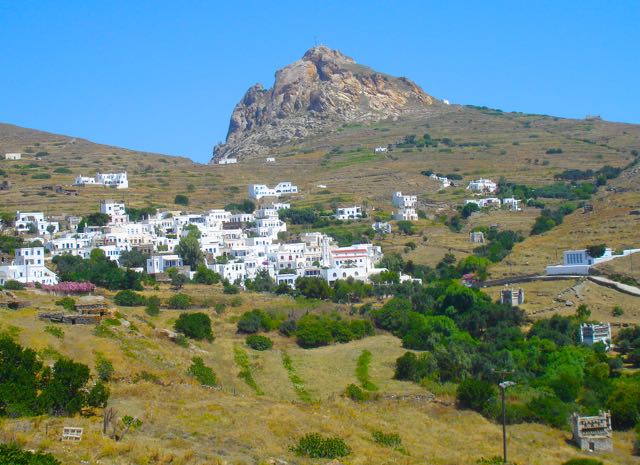 The giant towering rock that you can't help but notice is called Exombourgo and was the acropolis of Tinos in ancient times. The rock is 640 meters high and was so heavily fortified by the Venetians that they were able to repel Turkish raids long after the rest of the islands and most of the mainland had
fallen. It was finally deserted and dismantled by the Turks in 1715 but there are still some ruins of the Venetian town and if you make
the climb you will be rewarded with a spectacular view as well. Just below the walls is the Shrine of the Sacred Heart of Jesus, a Catholic monastery first built by the Jesuits in 1724. The courtyard contains a memorial to the Greek Catholics who died during the Balkan Wars, the First and Second World Wars and the Civil War which followed. The monastery now offers rooms for pilgrims to come and mediate or people who want to include prayer and spiritual study on their holiday. There's a little gift and
book shop with maps
and guidebooks if you have not found one yet. There is also a small museum with photos of all the Catholic Bishops of Tinos since.... well since they began taking photographs I guess. There's a caretaker who will give you a tour and tell you everything there is to know about the shrine as long as you speak Greek or Italian. If
you don't
speak either just smile and nod as he shows you around and then go buy something. There are some statues of Jesus that come in a variety of positions and sizes. Try not to buy one that is too big to fit in your suitcase. The giant towering rock that you can't help but notice is called Exombourgo and was the acropolis of Tinos in ancient times. The rock is 640 meters high and was so heavily fortified by the Venetians that they were able to repel Turkish raids long after the rest of the islands and most of the mainland had
fallen. It was finally deserted and dismantled by the Turks in 1715 but there are still some ruins of the Venetian town and if you make
the climb you will be rewarded with a spectacular view as well. Just below the walls is the Shrine of the Sacred Heart of Jesus, a Catholic monastery first built by the Jesuits in 1724. The courtyard contains a memorial to the Greek Catholics who died during the Balkan Wars, the First and Second World Wars and the Civil War which followed. The monastery now offers rooms for pilgrims to come and mediate or people who want to include prayer and spiritual study on their holiday. There's a little gift and
book shop with maps
and guidebooks if you have not found one yet. There is also a small museum with photos of all the Catholic Bishops of Tinos since.... well since they began taking photographs I guess. There's a caretaker who will give you a tour and tell you everything there is to know about the shrine as long as you speak Greek or Italian. If
you don't
speak either just smile and nod as he shows you around and then go buy something. There are some statues of Jesus that come in a variety of positions and sizes. Try not to buy one that is too big to fit in your suitcase.
|
|
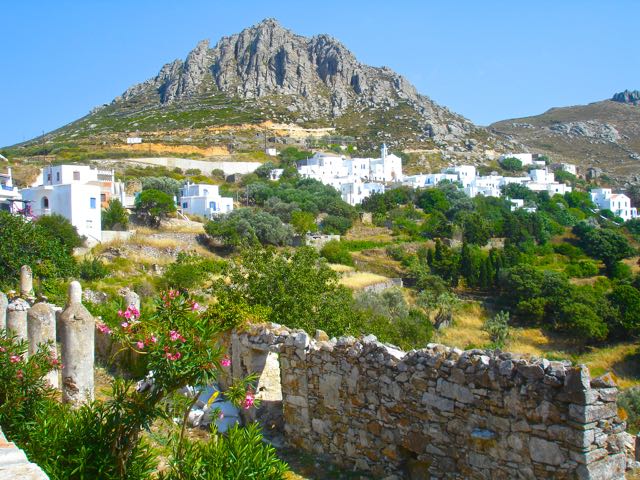 The village of Xinara is the capital of the Principality of Exombourgo and has a Religious and Folklore Museum as well as the Church of the Virgin Mary of Rodarios which is the primary church of the Catholic Archdiocese. The Mansion of the Archbishop is here as well. Nearby in the village of Loutra (baths)
another important
Catholic Village is the Ursuline Covent built in 1862 and where many daughter's of Greece's aristocracy went to school. and the Jesuit
Monastery which was built in 1661. Just after the village of Koumaros (photo) on the north side of the mountain is an interesting dilapidated building on the side of the road with some columns in the yard. Behind the building is a small ancient style amphitheatre being built out of stone. It could be a restoration or it could be some guy building an amphitheatre in his back yard. But its worth a visit. The village of Xinara is the capital of the Principality of Exombourgo and has a Religious and Folklore Museum as well as the Church of the Virgin Mary of Rodarios which is the primary church of the Catholic Archdiocese. The Mansion of the Archbishop is here as well. Nearby in the village of Loutra (baths)
another important
Catholic Village is the Ursuline Covent built in 1862 and where many daughter's of Greece's aristocracy went to school. and the Jesuit
Monastery which was built in 1661. Just after the village of Koumaros (photo) on the north side of the mountain is an interesting dilapidated building on the side of the road with some columns in the yard. Behind the building is a small ancient style amphitheatre being built out of stone. It could be a restoration or it could be some guy building an amphitheatre in his back yard. But its worth a visit.
|
|
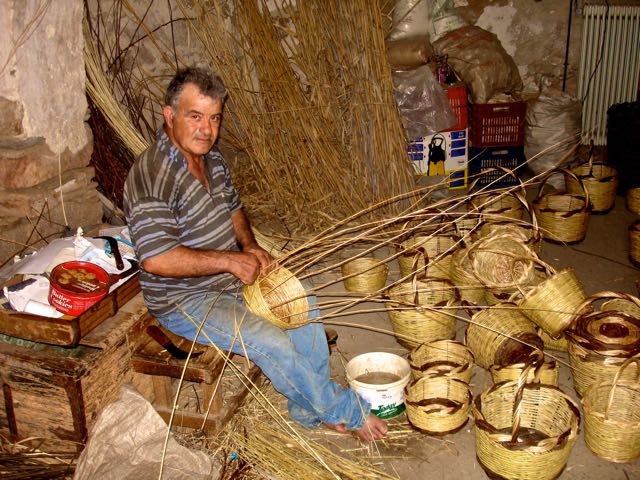 Speaking of amphitheatres the town of Volax is known for the giant stones that surround the village, its folklore museum and the workshops of the village basket-weavers and its tiny amphitheatre where they have programs in the summer. Falatados has the big church of Agia Triada and a folklore museum, as
well
as being known
for its wine and raki. (Like ouzo but home-made in a still and not flavored with anise)Potamia is an agricultural village with a church to the Panagia and is just above the beaches of Lihnaftia and Santa
Margarita. The town of Komi at the top of the campos (valley) of Kato Meria is known for the church of Agios Ioannis with its icon of the saint by the Italian painter Galiardi. The kalamia covered campos has several agricultural villages and a number of small farms, lots of water and roving gangs of cows. Its the most fertile area of the island and the center of Catholic Tinos. The road north will lead you to the beaches of Kolimbithres and Apothikes. Speaking of amphitheatres the town of Volax is known for the giant stones that surround the village, its folklore museum and the workshops of the village basket-weavers and its tiny amphitheatre where they have programs in the summer. Falatados has the big church of Agia Triada and a folklore museum, as
well
as being known
for its wine and raki. (Like ouzo but home-made in a still and not flavored with anise)Potamia is an agricultural village with a church to the Panagia and is just above the beaches of Lihnaftia and Santa
Margarita. The town of Komi at the top of the campos (valley) of Kato Meria is known for the church of Agios Ioannis with its icon of the saint by the Italian painter Galiardi. The kalamia covered campos has several agricultural villages and a number of small farms, lots of water and roving gangs of cows. Its the most fertile area of the island and the center of Catholic Tinos. The road north will lead you to the beaches of Kolimbithres and Apothikes.
|
|
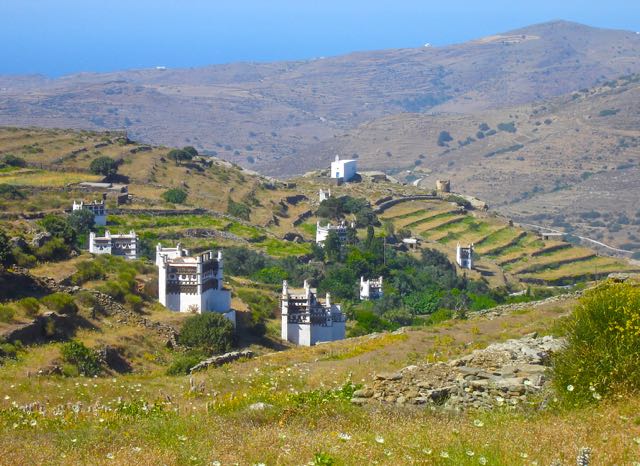 The villages of Tarambados and Smardakito are known for the dovecotes which are scattered around the hills and valleys outside of the towns. Said to have been brought to the island by the Venetians, the doves were a staple in the diet of the islanders and their droppings were used as fertilizer. The houses
that were
built for these flocks of birds are mostly from the 18th and 19th century and are all over the island but particularly around these villages. Each of these
buildings has a different design and though you will find them on many of the Cyclades islands, those in Tinos are the most interesting and abundant. The villages of Tarambados and Smardakito are known for the dovecotes which are scattered around the hills and valleys outside of the towns. Said to have been brought to the island by the Venetians, the doves were a staple in the diet of the islanders and their droppings were used as fertilizer. The houses
that were
built for these flocks of birds are mostly from the 18th and 19th century and are all over the island but particularly around these villages. Each of these
buildings has a different design and though you will find them on many of the Cyclades islands, those in Tinos are the most interesting and abundant.
|
|
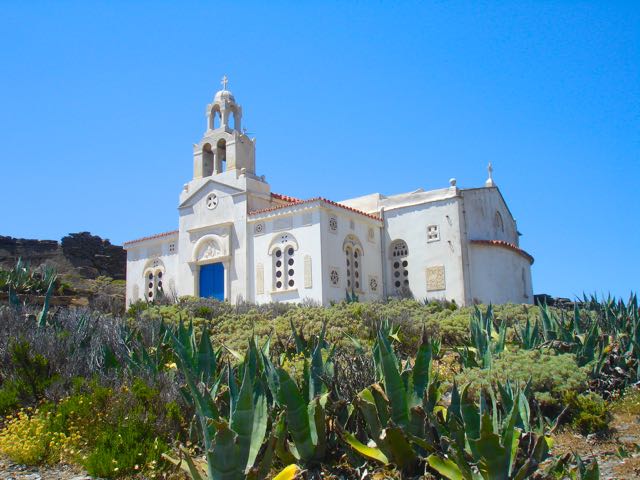 The village of Kardiani on the road that overlooks the southwestern coast of Tinos has springs, lush vegetation and tall platanos (sycamore) trees along with a great view of Syros. The village of Ysternia is known for its artists and their museum and the marble stones that pave the streets. It also overlooks a number
of beautiful
sandy beaches. Above the village is the 18th Century Katapoliani Monastery and a few remaining windmills. During the Venetian period
there were over eighty of them on the island, used for grinding wheat even into the middle of the last century. The port of Ysternia, called Ormos Ysternia, has a couple nice tavernas and a small beach and is a working port with ships coming to get stone from the quarries of the area. As the road leaves the coast to go inland towards Pirgos there is a collection of religious buildings, a sort of shrine with an interesting church and a dangerous looking garden of cactus and other unfriendly
plants. Check it out. If its windy don't get blown off the mountain. There are the ruins of some windmills across the road. The village of Kardiani on the road that overlooks the southwestern coast of Tinos has springs, lush vegetation and tall platanos (sycamore) trees along with a great view of Syros. The village of Ysternia is known for its artists and their museum and the marble stones that pave the streets. It also overlooks a number
of beautiful
sandy beaches. Above the village is the 18th Century Katapoliani Monastery and a few remaining windmills. During the Venetian period
there were over eighty of them on the island, used for grinding wheat even into the middle of the last century. The port of Ysternia, called Ormos Ysternia, has a couple nice tavernas and a small beach and is a working port with ships coming to get stone from the quarries of the area. As the road leaves the coast to go inland towards Pirgos there is a collection of religious buildings, a sort of shrine with an interesting church and a dangerous looking garden of cactus and other unfriendly
plants. Check it out. If its windy don't get blown off the mountain. There are the ruins of some windmills across the road.
|
|
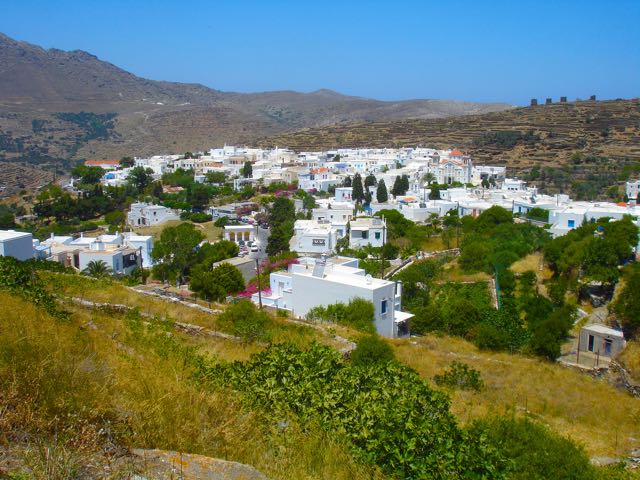 One of the largest and most attractive villages on Tinos is the town of Pirgos, famous for its marble sculpture artists, some of Greece's most well known, who have lived and/or studied here. There are two museums and the School of fine Arts which all have exhibitions by students and well known artists.
Pirgos itself is as beautiful as
the art you will find in it, with narrow streets, whitewashed Cycladic architecture and a quaint square with an ornate fountain, a couple cafes and a taverna. There are several other cafes and restaurants nearby and a number of galleries and art shops, many of them quite unique. If you are looking for a place to spend your money and return home with something of value spend your shopping day in Pirgos. One of the largest and most attractive villages on Tinos is the town of Pirgos, famous for its marble sculpture artists, some of Greece's most well known, who have lived and/or studied here. There are two museums and the School of fine Arts which all have exhibitions by students and well known artists.
Pirgos itself is as beautiful as
the art you will find in it, with narrow streets, whitewashed Cycladic architecture and a quaint square with an ornate fountain, a couple cafes and a taverna. There are several other cafes and restaurants nearby and a number of galleries and art shops, many of them quite unique. If you are looking for a place to spend your money and return home with something of value spend your shopping day in Pirgos.
|
|
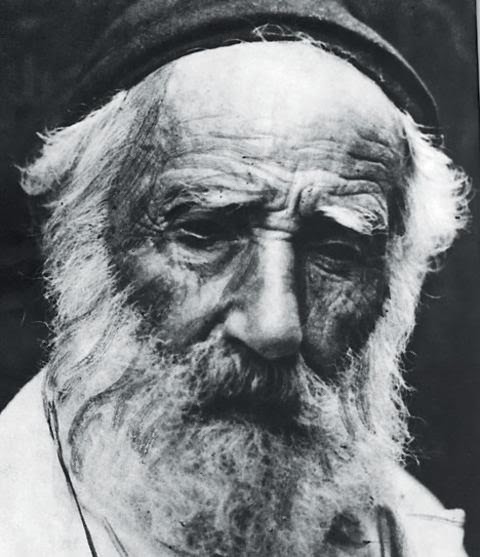 The Museum of Yianoulis Chalepas is the home of Greece's foremost sculptor, best known for the statue of a Sleeping Girl in Athens First Cemetery. The popular mythology is that when critics pointed out that his masterpiece, was not anatomically
correct he went mad and took his own life. He had an insane mother who destroyed many of his works and always bugged him about getting a real job, just like many people I know today. Chalepas also had a history of mental illness and was institutionalized,
though much of his work was created after his discharge from the asylum. One hundred and fifteen of his sculptures survive today, many of them on Tinos and to many he is considered the greatest of the modern Greek artists. The museum contains sketches and some copies of his works but also shows what a 19th Century island house is like. The Museum of Yianoulis Chalepas is the home of Greece's foremost sculptor, best known for the statue of a Sleeping Girl in Athens First Cemetery. The popular mythology is that when critics pointed out that his masterpiece, was not anatomically
correct he went mad and took his own life. He had an insane mother who destroyed many of his works and always bugged him about getting a real job, just like many people I know today. Chalepas also had a history of mental illness and was institutionalized,
though much of his work was created after his discharge from the asylum. One hundred and fifteen of his sculptures survive today, many of them on Tinos and to many he is considered the greatest of the modern Greek artists. The museum contains sketches and some copies of his works but also shows what a 19th Century island house is like.
Right next door is the Museum of Panormitan Artists which is mostly sculpture and reliefs. Both museums are a few steps away from the bus stop and the parking lot on the road to
Panormos. The School of Fine Arts in Pirgos is one of the most important art schools in Greece and a Mecca for young artists from all over the world who come here to compete for scholarships to the Athens School of Fine Arts.
Beyond Pirgos is the port of Panormos with several fish tavernas, a small tree shaded beach and some cafes. There is a tiny river here too. You can drive in either direction to find more beaches.
From Pirgos you can drive to the western tip of the island to see the small church of Agia Theodori and the islets of Kalogeri and Disvato and the island of Andros. This area of Tinos is rocky and barren with lots of marble outcrops. Most people skip it.
|
|
Ancient Footpaths of Tinos
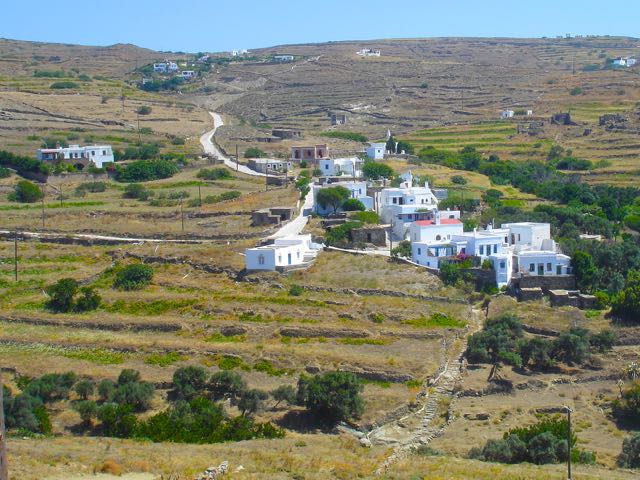 Tinos is blessed with 10 historical footpaths covering 63 kilometers which connect most of the villages and several of the beaches. The paths are marked with numbers and there are signposts at intersections which tell you which way to go and how long it should take you to get there. You should be able to find the pamphlet A Travelogue
of Tinos
by Tassos Anatassiou, (who has also done books and walking maps for Andros, Syros, and Kea) at the Tourist Information
or at the Town Hall in Tinos. We bought a copy at the Shrine of the Sacred Heart but you are supposed to be able to get it for free. The book contains maps of all the walking paths, general information on Tinos and descriptions of what you will see along each route. If you plan to walk in Tinos it is almost essential, though I suppose you could just follow numbers and signs and end up somewhere. Tinos is blessed with 10 historical footpaths covering 63 kilometers which connect most of the villages and several of the beaches. The paths are marked with numbers and there are signposts at intersections which tell you which way to go and how long it should take you to get there. You should be able to find the pamphlet A Travelogue
of Tinos
by Tassos Anatassiou, (who has also done books and walking maps for Andros, Syros, and Kea) at the Tourist Information
or at the Town Hall in Tinos. We bought a copy at the Shrine of the Sacred Heart but you are supposed to be able to get it for free. The book contains maps of all the walking paths, general information on Tinos and descriptions of what you will see along each route. If you plan to walk in Tinos it is almost essential, though I suppose you could just follow numbers and signs and end up somewhere.
|

 If you are not the type who really likes hanging out all day on the beach what is there to do in Tinos? Get in your car or hit the walking trails and explore. What really makes Tinos special are the many villages scattered around the island, each one different and all of them connected by excellent roads and a system
of walking paths which follow the kalderinia, the stone roads that the islanders have been using for centuries. These villages are considered to be the
model of the Cycladic architecture and contain picturesque arches, streets paved with flagstones and yards full of blooming flowers, churches both small and large, and fountains of clear running water from underground springs. Most of these villages have been declared traditional and are protected by the Greek Ministry of Culture.
If you are not the type who really likes hanging out all day on the beach what is there to do in Tinos? Get in your car or hit the walking trails and explore. What really makes Tinos special are the many villages scattered around the island, each one different and all of them connected by excellent roads and a system
of walking paths which follow the kalderinia, the stone roads that the islanders have been using for centuries. These villages are considered to be the
model of the Cycladic architecture and contain picturesque arches, streets paved with flagstones and yards full of blooming flowers, churches both small and large, and fountains of clear running water from underground springs. Most of these villages have been declared traditional and are protected by the Greek Ministry of Culture. The majority of the villages are located in the southeast quadrant of Tinos and you can find a good reason to visit any of them. Some villages are Catholic and some Greek Orthodox and all have churches of their particular faith, many of them quite beautiful. In fact Tinos has over one thousand Churches, compared to decadent
islands like Mykonos which only has something like 365. It is said that the ecclesiastical architecture
of Tinos with its simple beauty and religious faith is the perfect physical manifestation of spirit. While giant Churches like those in Western Europe or Agia Sophia in Constantinople seem to almost challenge God, the small country churches of Tinos, solitary and white have a beauty and humility that induces a meditative state rather than a sense of awe.
The majority of the villages are located in the southeast quadrant of Tinos and you can find a good reason to visit any of them. Some villages are Catholic and some Greek Orthodox and all have churches of their particular faith, many of them quite beautiful. In fact Tinos has over one thousand Churches, compared to decadent
islands like Mykonos which only has something like 365. It is said that the ecclesiastical architecture
of Tinos with its simple beauty and religious faith is the perfect physical manifestation of spirit. While giant Churches like those in Western Europe or Agia Sophia in Constantinople seem to almost challenge God, the small country churches of Tinos, solitary and white have a beauty and humility that induces a meditative state rather than a sense of awe. As in other Cyclades islands you will notice the stone terracing which is pretty much everywhere keeping the topsoil in place and turning steep hillsides that might otherwise be barren into farms and orchards that can last a thousand years. As far as vegetation goes Tinos is one of the more green islands with fertile valleys
with
ample water able to sustain the whole island were it necessary. But more than anything Tinos has stone: marble, granite and slate, and just about everything is built out of these rocks, from walls to streets to monuments and art. No wonder Tinos is known for its sculpture artists, and the father of Phideas, acknowledged as the greatest sculptor of all time whose most well known work was the Parthenon, came from Tinos.
As in other Cyclades islands you will notice the stone terracing which is pretty much everywhere keeping the topsoil in place and turning steep hillsides that might otherwise be barren into farms and orchards that can last a thousand years. As far as vegetation goes Tinos is one of the more green islands with fertile valleys
with
ample water able to sustain the whole island were it necessary. But more than anything Tinos has stone: marble, granite and slate, and just about everything is built out of these rocks, from walls to streets to monuments and art. No wonder Tinos is known for its sculpture artists, and the father of Phideas, acknowledged as the greatest sculptor of all time whose most well known work was the Parthenon, came from Tinos.  The three villages of Dio Horia, Triandaros and Berdemiaros are known as the 'balconies of Tinos' because of their spectacular view of the sea. Dio Horia is build ampitheatrically (I don't know if this is a real word but it works even if my spell-check does not like it) on the side of a mountain
and has a fountain enclosed in marble with a painting of the Panagia with the Child Jesus where offerings are left and candles lit for loved ones. Above is a small square and another
fountain with a depiction of the baptism of Jesus. Arnados is the highest village on Tinos and has a museum of iconography and the nearby Kechrovouni Convent which was founded in the 10th Century. Saint Pelagia, the nun who had the vision which led to the discovery of the famous Icon which is so venerated and the reason so many pilgrims flock to the island. Her panagiri (saint's day) is celebrated on July 23rd in the monastery which
also has a museum of 18th and
19th Century icons.
The three villages of Dio Horia, Triandaros and Berdemiaros are known as the 'balconies of Tinos' because of their spectacular view of the sea. Dio Horia is build ampitheatrically (I don't know if this is a real word but it works even if my spell-check does not like it) on the side of a mountain
and has a fountain enclosed in marble with a painting of the Panagia with the Child Jesus where offerings are left and candles lit for loved ones. Above is a small square and another
fountain with a depiction of the baptism of Jesus. Arnados is the highest village on Tinos and has a museum of iconography and the nearby Kechrovouni Convent which was founded in the 10th Century. Saint Pelagia, the nun who had the vision which led to the discovery of the famous Icon which is so venerated and the reason so many pilgrims flock to the island. Her panagiri (saint's day) is celebrated on July 23rd in the monastery which
also has a museum of 18th and
19th Century icons.  The giant towering rock that you can't help but notice is called Exombourgo and was the acropolis of Tinos in ancient times. The rock is 640 meters high and was so heavily fortified by the Venetians that they were able to repel Turkish raids long after the rest of the islands and most of the mainland had
fallen. It was finally deserted and dismantled by the Turks in 1715 but there are still some ruins of the Venetian town and if you make
the climb you will be rewarded with a spectacular view as well. Just below the walls is the Shrine of the Sacred Heart of Jesus, a Catholic monastery first built by the Jesuits in 1724. The courtyard contains a memorial to the Greek Catholics who died during the Balkan Wars, the First and Second World Wars and the Civil War which followed. The monastery now offers rooms for pilgrims to come and mediate or people who want to include prayer and spiritual study on their holiday. There's a little gift and
book shop with maps
and guidebooks if you have not found one yet. There is also a small museum with photos of all the Catholic Bishops of Tinos since.... well since they began taking photographs I guess. There's a caretaker who will give you a tour and tell you everything there is to know about the shrine as long as you speak Greek or Italian. If
you don't
speak either just smile and nod as he shows you around and then go buy something. There are some statues of Jesus that come in a variety of positions and sizes. Try not to buy one that is too big to fit in your suitcase.
The giant towering rock that you can't help but notice is called Exombourgo and was the acropolis of Tinos in ancient times. The rock is 640 meters high and was so heavily fortified by the Venetians that they were able to repel Turkish raids long after the rest of the islands and most of the mainland had
fallen. It was finally deserted and dismantled by the Turks in 1715 but there are still some ruins of the Venetian town and if you make
the climb you will be rewarded with a spectacular view as well. Just below the walls is the Shrine of the Sacred Heart of Jesus, a Catholic monastery first built by the Jesuits in 1724. The courtyard contains a memorial to the Greek Catholics who died during the Balkan Wars, the First and Second World Wars and the Civil War which followed. The monastery now offers rooms for pilgrims to come and mediate or people who want to include prayer and spiritual study on their holiday. There's a little gift and
book shop with maps
and guidebooks if you have not found one yet. There is also a small museum with photos of all the Catholic Bishops of Tinos since.... well since they began taking photographs I guess. There's a caretaker who will give you a tour and tell you everything there is to know about the shrine as long as you speak Greek or Italian. If
you don't
speak either just smile and nod as he shows you around and then go buy something. There are some statues of Jesus that come in a variety of positions and sizes. Try not to buy one that is too big to fit in your suitcase. The village of Xinara is the capital of the Principality of Exombourgo and has a Religious and Folklore Museum as well as the Church of the Virgin Mary of Rodarios which is the primary church of the Catholic Archdiocese. The Mansion of the Archbishop is here as well. Nearby in the village of Loutra (baths)
another important
Catholic Village is the Ursuline Covent built in 1862 and where many daughter's of Greece's aristocracy went to school. and the Jesuit
Monastery which was built in 1661. Just after the village of Koumaros (photo) on the north side of the mountain is an interesting dilapidated building on the side of the road with some columns in the yard. Behind the building is a small ancient style amphitheatre being built out of stone. It could be a restoration or it could be some guy building an amphitheatre in his back yard. But its worth a visit.
The village of Xinara is the capital of the Principality of Exombourgo and has a Religious and Folklore Museum as well as the Church of the Virgin Mary of Rodarios which is the primary church of the Catholic Archdiocese. The Mansion of the Archbishop is here as well. Nearby in the village of Loutra (baths)
another important
Catholic Village is the Ursuline Covent built in 1862 and where many daughter's of Greece's aristocracy went to school. and the Jesuit
Monastery which was built in 1661. Just after the village of Koumaros (photo) on the north side of the mountain is an interesting dilapidated building on the side of the road with some columns in the yard. Behind the building is a small ancient style amphitheatre being built out of stone. It could be a restoration or it could be some guy building an amphitheatre in his back yard. But its worth a visit.  Speaking of amphitheatres the town of Volax is known for the giant stones that surround the village, its folklore museum and the workshops of the village basket-weavers and its tiny amphitheatre where they have programs in the summer. Falatados has the big church of Agia Triada and a folklore museum, as
well
as being known
for its wine and raki. (Like ouzo but home-made in a still and not flavored with anise)Potamia is an agricultural village with a church to the Panagia and is just above the beaches of Lihnaftia and Santa
Margarita. The town of Komi at the top of the campos (valley) of Kato Meria is known for the church of Agios Ioannis with its icon of the saint by the Italian painter Galiardi. The kalamia covered campos has several agricultural villages and a number of small farms, lots of water and roving gangs of cows. Its the most fertile area of the island and the center of Catholic Tinos. The road north will lead you to the beaches of Kolimbithres and Apothikes.
Speaking of amphitheatres the town of Volax is known for the giant stones that surround the village, its folklore museum and the workshops of the village basket-weavers and its tiny amphitheatre where they have programs in the summer. Falatados has the big church of Agia Triada and a folklore museum, as
well
as being known
for its wine and raki. (Like ouzo but home-made in a still and not flavored with anise)Potamia is an agricultural village with a church to the Panagia and is just above the beaches of Lihnaftia and Santa
Margarita. The town of Komi at the top of the campos (valley) of Kato Meria is known for the church of Agios Ioannis with its icon of the saint by the Italian painter Galiardi. The kalamia covered campos has several agricultural villages and a number of small farms, lots of water and roving gangs of cows. Its the most fertile area of the island and the center of Catholic Tinos. The road north will lead you to the beaches of Kolimbithres and Apothikes. The villages of Tarambados and Smardakito are known for the dovecotes which are scattered around the hills and valleys outside of the towns. Said to have been brought to the island by the Venetians, the doves were a staple in the diet of the islanders and their droppings were used as fertilizer. The houses
that were
built for these flocks of birds are mostly from the 18th and 19th century and are all over the island but particularly around these villages. Each of these
buildings has a different design and though you will find them on many of the Cyclades islands, those in Tinos are the most interesting and abundant.
The villages of Tarambados and Smardakito are known for the dovecotes which are scattered around the hills and valleys outside of the towns. Said to have been brought to the island by the Venetians, the doves were a staple in the diet of the islanders and their droppings were used as fertilizer. The houses
that were
built for these flocks of birds are mostly from the 18th and 19th century and are all over the island but particularly around these villages. Each of these
buildings has a different design and though you will find them on many of the Cyclades islands, those in Tinos are the most interesting and abundant. The village of Kardiani on the road that overlooks the southwestern coast of Tinos has springs, lush vegetation and tall platanos (sycamore) trees along with a great view of Syros. The village of Ysternia is known for its artists and their museum and the marble stones that pave the streets. It also overlooks a number
of beautiful
sandy beaches. Above the village is the 18th Century Katapoliani Monastery and a few remaining windmills. During the Venetian period
there were over eighty of them on the island, used for grinding wheat even into the middle of the last century. The port of Ysternia, called Ormos Ysternia, has a couple nice tavernas and a small beach and is a working port with ships coming to get stone from the quarries of the area. As the road leaves the coast to go inland towards Pirgos there is a collection of religious buildings, a sort of shrine with an interesting church and a dangerous looking garden of cactus and other unfriendly
plants. Check it out. If its windy don't get blown off the mountain. There are the ruins of some windmills across the road.
The village of Kardiani on the road that overlooks the southwestern coast of Tinos has springs, lush vegetation and tall platanos (sycamore) trees along with a great view of Syros. The village of Ysternia is known for its artists and their museum and the marble stones that pave the streets. It also overlooks a number
of beautiful
sandy beaches. Above the village is the 18th Century Katapoliani Monastery and a few remaining windmills. During the Venetian period
there were over eighty of them on the island, used for grinding wheat even into the middle of the last century. The port of Ysternia, called Ormos Ysternia, has a couple nice tavernas and a small beach and is a working port with ships coming to get stone from the quarries of the area. As the road leaves the coast to go inland towards Pirgos there is a collection of religious buildings, a sort of shrine with an interesting church and a dangerous looking garden of cactus and other unfriendly
plants. Check it out. If its windy don't get blown off the mountain. There are the ruins of some windmills across the road. One of the largest and most attractive villages on Tinos is the town of Pirgos, famous for its marble sculpture artists, some of Greece's most well known, who have lived and/or studied here. There are two museums and the School of fine Arts which all have exhibitions by students and well known artists.
Pirgos itself is as beautiful as
the art you will find in it, with narrow streets, whitewashed Cycladic architecture and a quaint square with an ornate fountain, a couple cafes and a taverna. There are several other cafes and restaurants nearby and a number of galleries and art shops, many of them quite unique. If you are looking for a place to spend your money and return home with something of value spend your shopping day in Pirgos.
One of the largest and most attractive villages on Tinos is the town of Pirgos, famous for its marble sculpture artists, some of Greece's most well known, who have lived and/or studied here. There are two museums and the School of fine Arts which all have exhibitions by students and well known artists.
Pirgos itself is as beautiful as
the art you will find in it, with narrow streets, whitewashed Cycladic architecture and a quaint square with an ornate fountain, a couple cafes and a taverna. There are several other cafes and restaurants nearby and a number of galleries and art shops, many of them quite unique. If you are looking for a place to spend your money and return home with something of value spend your shopping day in Pirgos. The Museum of Yianoulis Chalepas is the home of Greece's foremost sculptor, best known for the statue of a Sleeping Girl in Athens First Cemetery. The popular mythology is that when critics pointed out that his masterpiece, was not anatomically
correct he went mad and took his own life. He had an insane mother who destroyed many of his works and always bugged him about getting a real job, just like many people I know today. Chalepas also had a history of mental illness and was institutionalized,
though much of his work was created after his discharge from the asylum. One hundred and fifteen of his sculptures survive today, many of them on Tinos and to many he is considered the greatest of the modern Greek artists. The museum contains sketches and some copies of his works but also shows what a 19th Century island house is like.
The Museum of Yianoulis Chalepas is the home of Greece's foremost sculptor, best known for the statue of a Sleeping Girl in Athens First Cemetery. The popular mythology is that when critics pointed out that his masterpiece, was not anatomically
correct he went mad and took his own life. He had an insane mother who destroyed many of his works and always bugged him about getting a real job, just like many people I know today. Chalepas also had a history of mental illness and was institutionalized,
though much of his work was created after his discharge from the asylum. One hundred and fifteen of his sculptures survive today, many of them on Tinos and to many he is considered the greatest of the modern Greek artists. The museum contains sketches and some copies of his works but also shows what a 19th Century island house is like.  Tinos is blessed with 10 historical footpaths covering 63 kilometers which connect most of the villages and several of the beaches. The paths are marked with numbers and there are signposts at intersections which tell you which way to go and how long it should take you to get there. You should be able to find the pamphlet A Travelogue
of Tinos
by Tassos Anatassiou, (who has also done books and walking maps for Andros, Syros, and Kea) at the Tourist Information
or at the Town Hall in Tinos. We bought a copy at the Shrine of the Sacred Heart but you are supposed to be able to get it for free. The book contains maps of all the walking paths, general information on Tinos and descriptions of what you will see along each route. If you plan to walk in Tinos it is almost essential, though I suppose you could just follow numbers and signs and end up somewhere.
Tinos is blessed with 10 historical footpaths covering 63 kilometers which connect most of the villages and several of the beaches. The paths are marked with numbers and there are signposts at intersections which tell you which way to go and how long it should take you to get there. You should be able to find the pamphlet A Travelogue
of Tinos
by Tassos Anatassiou, (who has also done books and walking maps for Andros, Syros, and Kea) at the Tourist Information
or at the Town Hall in Tinos. We bought a copy at the Shrine of the Sacred Heart but you are supposed to be able to get it for free. The book contains maps of all the walking paths, general information on Tinos and descriptions of what you will see along each route. If you plan to walk in Tinos it is almost essential, though I suppose you could just follow numbers and signs and end up somewhere. 
